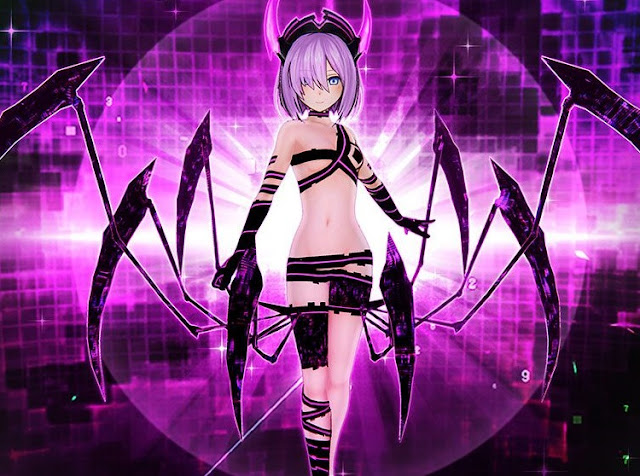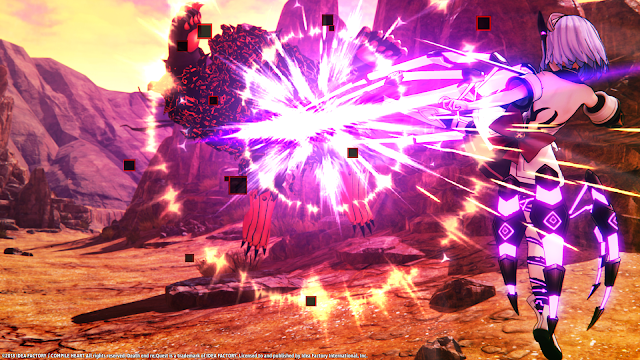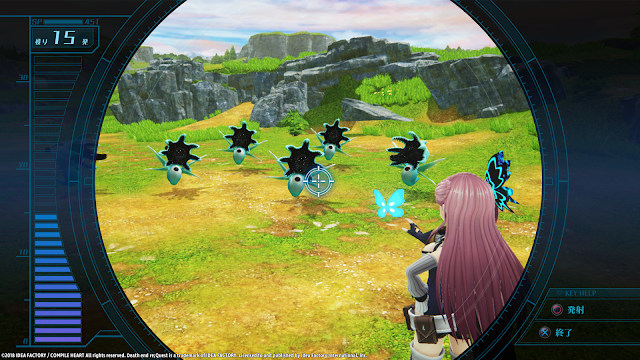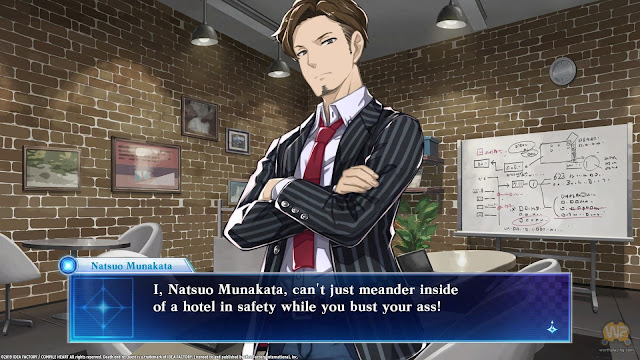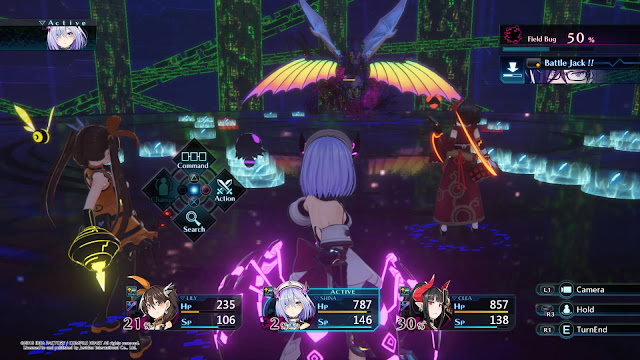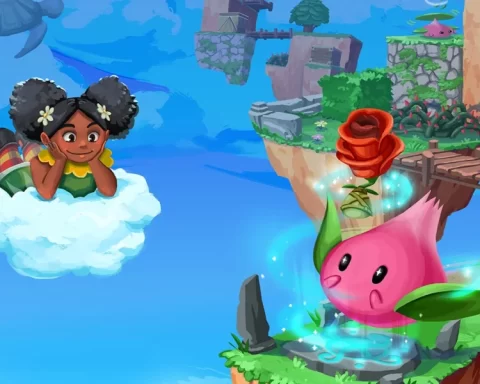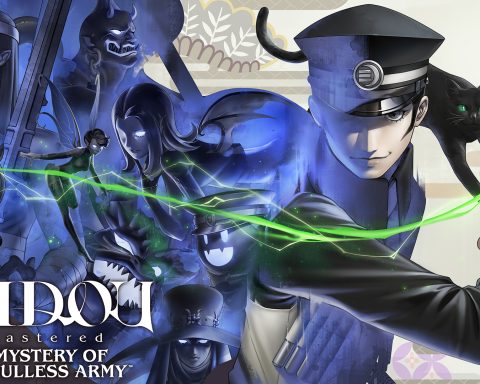Review by Matt S.
Idea Factory games are always smarter than people give them credit for. People see the fan service (which is always copious), but then can’t look past that. It becomes the defining characteristic of the game to them, and that’s disappointing, because there’s always much more to the typical Idea Factory effort than that. Death End re:Quest is almost certain to be a victim of the exact same perception, but in so many ways it’s Idea Factory’s most mature project to date.
But first, the fan service. Death End doesn’t hold back here, even by Idea Factory’s standards. The protagonist, Shina, wears a skirt so short that it’s almost impossible to find a camera angle where she’s not flashing her panties with every step that she takes. The default camera angle – positioned immediately behind her at a straight body height, hides absolutely nothing. Furthermore, in combat the protagonist and all her allies can sometimes enter “transformed” forms, which powers them up significantly, and is particularly useful for boss battles. It also replaces their clothes with little more than black stickers over their nipples and crotches.
Yes, it is easy to argue that Death End pushes the fan service further than any Idea Factory game to date. In fairness to the inevitable group of reviewers who are going to criticise this (to the chagrin of those who refuse to accept any criticism of fan service), in the case of Death End, that fan service really does feel superficial and pointless.
With Idea Factory’s highly satirical Hyperdimension Neptunia series, the pervy stuff helped serve the satire. Each game in that series pokes plenty of self-referential jokes at games for the “otaku” and anime markets. Another of its titles, Omega Quintet, was a game that likewise lampooned idol culture. Having the girls cover themselves and yell at you for tilting the camera too low was, again, an appropriate use of fan service to the narrative and themes. With something like Mary Skelter, a dungeon crawler built around themes of fetishes and horror, the fan service was once again thematically appropriate. It was meant to be a game with a a sexual tone running through it.
However, with some of Idea Factory’s other efforts, the fan service does comes across as unnecessary and poorly matched to what the game’s trying to do. Dark Rose Valkyrie certainly had its share of cute characters – Ai for life and all that – but that was a relatively serious game by Idea Factory about militarism and betrayal and things, and the pink lacies didn’t really suit the theme. Death End Re:Quest has an incredibly serious basis, and again, as an otherwise seriously toned game, the upskirts and nipple Band-Aids simply don’t fit.
With or without the fan service, though, Death End Re:Quest is an absolutely cracking game. It drives at a surprisingly complex narrative, but to summarise the setup as briefly as I can; There’s a prototype MMO that was shut down by its publisher a year ago. By chance, one of the developers discovers that the servers for it are still live, despite his previous understanding that they were all shuttered. There, he discovers something even more incredible – the lead on the project (Shina), who went missing at the same time that the game was shuttered, is actually inside the bug-ridden, decrepit state of the game.
See, this game allowed people to put themselves directly into the game via VR technology. Unfortunately, thanks to the state of the game and its bugs, there’s no way for the girl to get back out… and no one knows where her body is located in the real world. So, with the help of the programmer dude in the real world, she sets out on a quest to complete the game (battling all the bugs along the way) in order to free her mind from it, and allow her to return to her body.
Meanwhile, real-world objects keep showing up in the in-game world, to the confusion of all involved. More concerning is that as the real-world protagonist gets more involved in the game and Shina’s quest, some really terrifying stuff starts happening to him in the real world. He starts having encounters with ghosts and other occultish things, and masked people that look like something straight out the Strangers film franchise show up threateningly up at his door. That’s just the tip of the iceberg, too. The sense is that he’s in all kinds of trouble, and it comes on thick and fast. It all starts to point towards some kind of giant conspiracy, and figuring out the relationship between what’s going on in the real world, to the continued existence of the game world, forms the basis for the rest of the adventure. Does it become a bit predictable at times? Sure… but without giving away spoilers, the final chapters are thrilling stuff.
Death End offers a lot to take in, but thankfully the narrative does a brilliant job of making it the kind of mystery that you want to solve. For anything up to an hour at a time you’ll be reading through what can only be described as visual novel sequences as you work your way through the plot. At first, this seems like jarringly long breaks from the JRPG action, but as the narrative settles into its own rhythm the blend of VN and JRPG is nicely complementary. There are shades of everything from Sword Art Online to Suzuki Koji’s The Ring series of novels, and even a touch of the Murakami Haruki approach to thrillers in Death End. The way the sense of mystery is structured so it cleverly builds sequences of mundane, every day events and meetings into something that feels distinctly sinister and unnatural could surely have only been inspired by 1Q84… and while 1Q84 is in the league of Shakespeare himself for pure literary value, the fact that Death End is in the same ballpark, thematically and tonally, is genuinely impressive from a developer better known for nonsense stories about purple-haired pudding enthusiasts with absolutely no shame about their bodies.
It’s easy to look at Death End as simply being another story about people getting themselves trapped in virtual worlds. Sword Art Online make this theme nearly a cliché all by itself, but there are plenty of other anime and games that have done something similar. That being said, the stronger link to what’s going on the real world to the virtual spaces makes Death End more in-line with the science fiction thriller, such as the third book in the Ring trilogy, and this idea of people being “stuck” in simulations plays nicely to one of the more popular philosophical mind games going on at the moment, about whether humanity itself is in some kind of simulation. Death End touches on that theme a little, too. It’s not core to the narrative, but it does help to differentiate it from the straight fantasy of peers like Sword Art Online.
The way the story is structured within the game is both varied and intriguing too. As you play, you’ll be shifting between the “real world” and the “in-game world”. In the real world you’ll be dealing with the rabbit masked horror homages and corporate conspiracies. In the video game would you’ll be dealing with all kinds of MMO tropes that have been twisted – badly – by the bugs and unfinished nature of the game. Those bugs tend to have a violent effect on the characters – and indeed it’s possible to make bad decisions that lead to some incredibly gruesome endings.
For one example, the first “quest” you face in the game is to make your way through a castle where the bugs have corrupted all the soldiers in a bid to save the king from madness. One of your allies just happens to be the king’s daughter, and as you approach the throne room, she rushes off to try and talk to her father. Without giving away specifics, if you chase after her, you’ll get to fight the quest’s end boss (which might or might not be her father – I promise, no spoilers here, but it’s not what you’ll immediately expect). The first time I got to this point, however, I figured that I would be facing a boss soon, and made a practical decision go back to the nearest save point to prepare for the encounter. But in moving in the opposite direction I actually triggered a quite sickening cut scene and game over screen (again, no spoilers). Death End has a seemingly unlimited number of “game over” circumstances, which are always based directly on your actions through the narrative and outside of the combat. Importantly, many of them are not projected in advance. In hindsight, as you begrudgingly load up the save file, you’ll realise that yes, the decision that you made really did deserve to result in the entire party being killed. So it’s more a case of it being fascinating that the developers made character death and the “game over” screen so organic, than it is frustrating. Even when you’ve lost a solid half hour’s progress.
It’s worth emphasising that Death End re;Quest’s death scenes really are extreme. The visualisation of them is limited (one suspects due to budget constraints), but just as in the Corpse Party series, the description of how a character dies, and the accompanying sound effects, are extreme enough that Marquis De Sade himself would have been proud. It’ll be uncomfortable to plenty of people, and there’s no way around that, but it is well written and thematically appropriate. Just as Sade’s writing is both deeply uncomfortable and yet thematically on-point. As my old mate, Bataille, wrote in Eroticism: Death and Sensuality: “beauty is desired in order that it may be befouled; not for its own sake, but for the joy brought by the certainty of profaining it.” So I guess you could argue that the fan service in Death End does have a point after all.
(Not really, the game still didn’t need the flashing panties to make these death scenes of an uncomfortably high impact, any more than Corpse Party did).
Gameplay itself is very standard Idea Factory JRPG stuff. Dungeon designs are very reminiscent of the standard Hyperdimension Neptunia formula, though there’s a bit of light puzzle solving involved, and you’ll often need to jump back to the “real world” to complete some story-based sequences that result in bugs being squashed in the game world, which in turn allows the party to move on. As simple as these dungeons are mechanically, they’re broken up better with story bits than many Idea Factory games in the past, and they are longer and more protracted environments to explore as a result. This has the effect of making those environments feel less superficial and arbitrary, and they’re more enjoyable to explore as a result.
Combat, too, builds on the Hyperdimension formula. When combat is joined, your characters are arrayed in a circular arena with the enemy, which they can move freely around, and each side takes turns to use a blend of physical, ranged, and magic attacks until one side falls over. The big difference with Death End is the role of positioning. At the end of each attack, you can knock your opponent for a short distance. If they bump into the “wall” of the arena they’ll take additional damage. If they are pushed into an ally, the ally will get a bonus attack. If they bump into other enemies, they’ll send those enemies flying around too for some mass carnage. Because enemies tend to have a lot of health and do a lot of damage if they get a chance to counter-attack, it’s absolutely essential to take advantage of these combat features, and because of them every battle remains engaging; you’re never simply be “button mashing” your way through the same series of attacks – a habit many turn-based JRPGs can fall into – because on every turn you need to re-think positioning and the angles of attacks.
There’s a range of other features that introduce further complexity to combat. Combat arenas are littered with glowing orbs, which do damage to your characters if they run through them. Knock an enemy through them, however, and you’ll clear the orbs away quickly. Once over half the orbs are removed, the hacker guy in the real world can jump in and offer assistance, most notably with the ability to “transform” the environment, temporarily, into a different game genre. In practice turning the environment into a “FPS” or “Fighting Game” just lets your character do powerful special attacks on the enemy with a different visual skin, but selecting the right special conditions is important, particularly where bosses are concerned. There’s also the ability to strip the characters down to Band-Aids, as mentioned above, which powers them up significantly.
Most of those additional combat features are busywork for the sake of complexity, and don’t really add enough to the combat system to be worth the energy learning how to use them. Idea Factory does have a habit of making its games needlessly complex, perhaps to create the illusion of depth, when the base structure is perfectly sound all by itself. Then again, this is a developer and publisher of ultra-niche JRPGs, and Idea Factory’s team also know full well that its target audience would be comfortable with the complexity anyway. At least the developer has overcome its historic inability to make tutorials worth a damn. Death End re;Quest does a far better job on-boarding newer players and making sure they’re comfortable with its systems than other games in the Idea Factory library.
It’s a pity that there will be some (or many) who will inevitably dismiss Death End re;Quest as an anime fan service game, because it has a smart core under those trappings. As a blend of visual novel and JRPG, and as a blend of science fiction and conspiracy thriller that has a good, sharp bite to it, I would have to say this is the most inherently interesting game that Idea Factory has created to date.
– Matt S.
Editor-in-Chief
Find me on Twitter: @digitallydownld
Please help keep DDNet running: Running an online publication isn’t cheap, and it’s highly time consuming. Please help me keep the site running and providing interviews, reviews, and features like this by supporting me on Patreon. Even $1/ month would be a hugely appreciated vote of confidence in the kind of work we’re doing. Please click here to be taken to my Patreon, and thank you for reading and your support!

